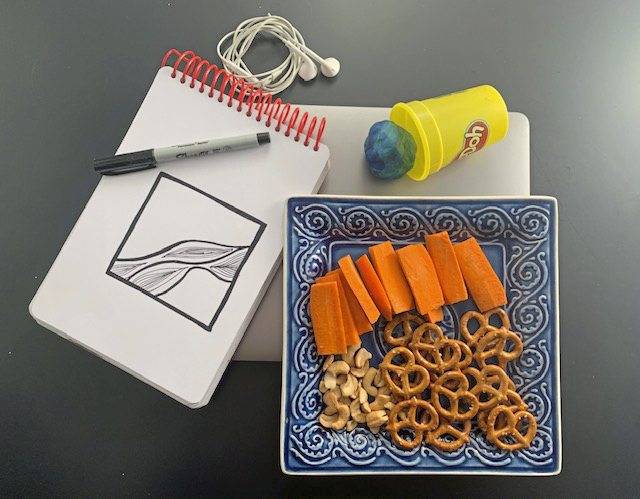When Miriam La Forest’s 11-year-old daughter, Chelsea, took an hour to complete 20 minutes worth of online school work, La Forrest knew a break was in order.
“It was literally after every subject just because she was over it,” said La Forrest, 47, of Brookline. “It means she fell asleep or she’d say she was just staring at the same page.”
Cues such as glazed-over eyes, distraction and fidgeting are clear signs that a child is at the end of their attention span and in need of what many professionals refer to as a “brain break,” or a mental rest designed to help students regain focus.
Recognizing that waning attention before it turns into frustration is a skill worth mastering as many families are tasked with educating their children at home this fall.
“You can’t be turned on all the time,” said Ann Marie Hines, art therapist, professional counselor and owner of Heal with Creativity LLC in Shaler. “There is such a thing as being overworked and overloaded as we know with adults. It definitely happens to kids and it happens a lot faster because they don’t necessarily have the same amount of attention span to be able to just sit and do, especially a non-preferred task.”
As a general rule, parents can expect 15 to 20 minutes of continuous attention from a kindergarten student and 45 to 50 minutes by the time they reach high school, according to Brianne Reyes, owner and occupational therapist at Childhood Enrichment Therapy i Trafford.
“For every 15 to 30 minutes that you’re doing academics, I’d say to give kids a five minute brain break,” she said. “If you’re getting the most out of your five minutes, then you’re not going to need an excessive brain break.”
A good brain break includes a sense-stimulating activity as a way to vary how the brain is being used.
“Some kids get wound up with too much movement, and they can’t settle and sit back down.,” Reyes said. Some kids need that kind of movement to be able to focus. It’s not one-size fits all. It all depends on what their body needs.”
La Forest lets Chelsea make that decision on her own.
“She would take the dog for a walk or go outside and skateboard for a little bit,” La Forest said.
A Texas Christian University initiative, known as the LiiNK Project, has formalized the idea of brain breaks. The project, which is based on the top-performing Finnish model of education, works with school districts to implement four 15-minute periods of unstructured, outdoor play into a typical school day. Based on their research, that number and frequency of breaks has been associated with increased focus, improved academics, decreased behavioral diagnoses (such as anxiety or attention deficit hyperactivity disorder, ADHD) and improved creativity and social skill development.
Designing brain breaks is limited only by creativity, but here are five expert-recommended ideas to keep kids on track.
1. Obstacle Course
“You can make it as simple or as challenging as you want,” said Reyes. “You don’t have to go out and buy stuff; just use stuff you have at home.”
Use chalk to draw obstacle prompts on cement. Create a Hula-Hoop challenge or use the hoops as stepping stones. Crawl through tents or tunnels. Decide that a sidewalk crack is a balance beam.
“Anything that gets them doing some motor planning and some movement together is fantastic,” said Reyes. “Especially if kids are going to be doing online learning, they’re going to need some kind of relief so an obstacle course would be great.”
2. Molding clay/dough
“There’s a huge practice in being able to push, squeeze, use your hands, move around and also disconnect,” said Hines.
Hines asks childhood clients to create characters from the clay or dough, which can then be used for pretend play. And, the character can be left to dry as a permanent addition to the child’s toy collection.
“They go into their own little world, and they’re able to escape into that and really just disconnect into it and have fun,” said Hines. “Then they have this end product as this relatable thing.”
3. Crunchy snack
“Oral activity helps to increase focus,” said Reyes. “Something chewy that makes their jaw work a little more to get that input or something crunchy like pretzels, fresh vegetables or nuts, if they’re allowed to have nuts.”
When a snack isn’t appropriate, the same muscle group can be activated by some creative straw activities. Suck a thick liquid, like applesauce, through a straw or have a “race” by blowing an accordion strip of paper across the table.
4. Zentangle
“There’s Zentangle like you see on Pinterest, and then there’s Zentangle, the meditative drawing practice,” said Hines. “However you approach it, it’s still a type of meditation, it’s just a type of active meditation.”
Invented by Maria and Rick Roberts and taught by certified teachers (and YouTube channels) world wide, Zentangle is a practice of using small squares of paper to create spur-of-the-moment designs, which emphasizes the process rather than the result.
“The other piece that makes it kind of more of a mediation practice is using a permanent pen or marker because there’s no such thing as a mistake,” said Hines. “The purpose of really practicing being in the moment is taking a ‘mistake’ and making that into a new design. It’s about going with the flow, being in the moment and practicing that presence.”
5. Jumping
“Any jumping activity where they’re getting that input through their joints would be fantastic,” said Reyes.
Whether achieved with a trampoline, jumping rope, a round of jumping jacks or just tennis shoes and a floor, jumping is an energy-zapping, whole-body activity ideal for opposing the seated, focused attention necessary for remote learning.








